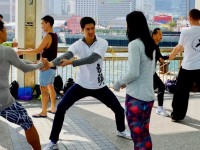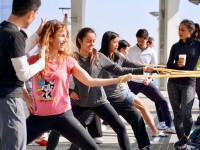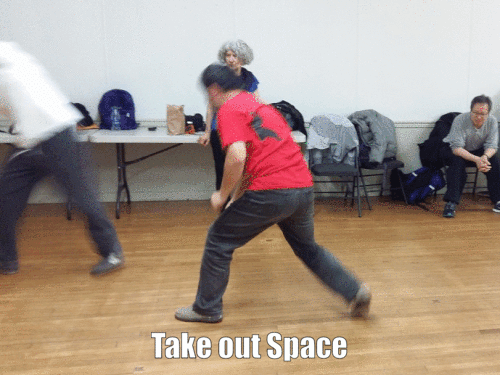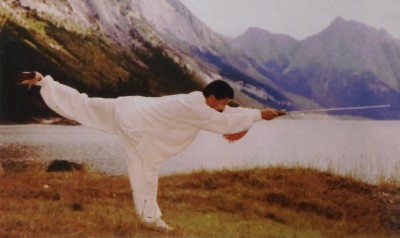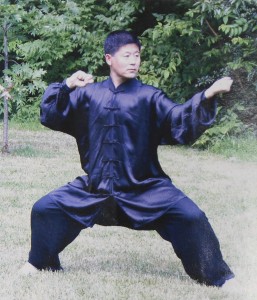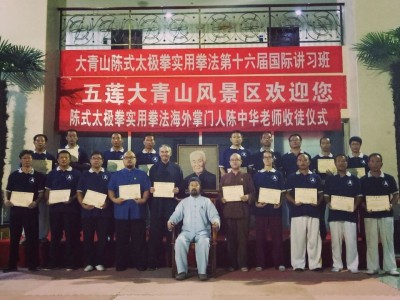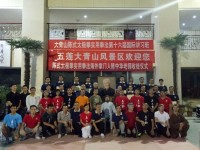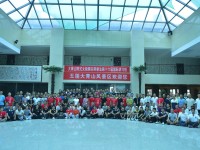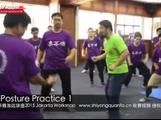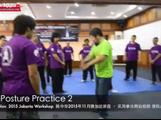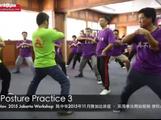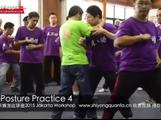Fetch water – the opposite vectors are at the front kua. Six sealing four closing/seven inch knife – separates at the shoulder.
News : Blog
You can follow Master Chen’s blogs here.
We continued the topic about the triangle in today’s class. To apply the triangle during push hand or Yilu we need to realize the following keys:
- How many triangles are needed
- The more the better as long as it can contribute the indirect force to the final result.
- My understanding is we need at least two: the first one is formed in upper body. It involves contact points. The triangle can be two hands + one shoulder or one hand + elbow + shoulder or one hand + two shoulders; the second one is formed in lower body. It can be one foot + kua + shoulder or two feet + kua. This perfectly explains the theory of “rooted in the feet, initiated from the legs, controlled by the waist, ended in the fingers”(其根在脚,发于腿,主宰于腰,形于手指).
- Apply one triangle on top of another
- Keep this in mind: fix one and then apply next. This is required by the rule of “Don’t move”.
- Build a solid structure
- A solid structure will be like a rod or chair. Opponent’s power will be directed to ground and bounced back to them easily.
- The solid structure will also support forming triangles.
- We always look for opponent’s weak point in their structure, so we can apply our triangles accordingly.
At the moment Master Chen is giving the 21th Practical Method Seminar on Daqinshan. More then 80 peoples are participating and there are both advanced (beneath them many disciples) and beginners.
I want to give you a brief insight of this event.
Asking the difference between external and internal martial arts, today Master Chen Zhonghua put it this way:
“External styles use brute force, internal styles use manipulation.”
Today we covered 5 exercises. Here are some corrections Kelvin Ho gave me and reminders in class as I understood at the time.
1)Twisting the Towel -Don’t move arms with arms but move arms and hands from same side foot. Make sure pelvis doesn’t move. Remember to keep hands stretched out and to stretch through whole arm. Keep on the centre line.
Read more
Another exciting two hours today in Richmond Hill class. Two notes to share with audients:
- Actually using triangle to apply indirect power is not a new topic, but today our practice really impressed me. I started to understand how important it is and how to apply it to all forms.
- How to form a triangle: hold two hands together as point A and two elbows are the other two points (point B and point C). Partner tries to hold the two elbows tightly using his two hands.
- Practice one: push two elbows out against partner’s two hands. It is very hard. Read more
Daqinghan on 2017-01-27 / 28
We had the honor to spend the last days together with Master Chen Zhonghua and a small group of other dedicated students. Chinese New Year, people also call it “The Spring Festival”, is the most important Chinese festival. Usually people spend it with the closest members of their families. But as our Masters family is Canadian we had the great opportunity to be together with him for this special day. Read more
I have two notes about today’s exercise:
- I have new understanding about the three foundations. The following sample assumes right hand is front hand.
- All of them are in different forms, but the requirements are same in terms of how to apply rules and principles.
- The final result is also same: front arm and hand are squeezed and drilling out.
- Common rules to remember:
- Lock both knees
- Lock hand, shoulder and kua on the back side
- Head up to keep body up straight
- Do not twist wrist
- Ensure the whole body acts as one entity , and every part is connected and supporting each other. This is so called 整劲.
- Apply two major triangles:
- Triangle one: left hand, right hand and front kua. Bring front kua into the line connecting two hands.
- Triangle two: left hand, right hand and front shoulder. Two actions are involved in order to bring front shoulder into the line connecting two hands: a) Sink the shoulder; b)bring front elbow towards body center line(vertical). This action will typically leads to drilling effect (顺缠).
- Yilu correction by Kelvin Ho
- Turning during “Turn to double lotus” and “Turn left to pound mortar”
- Form a rod from shoulder to kua to heel on the turning side
- Turn front foot
- Turn front kua. This can be easily forgotten
- Head up to keep body up straight
- Dragon on the ground
- First step: move weight to left, keep body up straight (I was leaning toward) when close two arms
- Second step: apply fetch water to open arms
In today’s class Kelvin Ho has provided feedback. The following are what I remembered:
- Detailed steps for turning body during “Buddha’s warrior attendant pounds the mortar”:
- before turn the body to left, fix every part of the body
- Stretch head upward
- turn left foot to left 45 degree, align left knee with left foot
- form a rod on left side of the body: maintain the left leg position by pushing knee backward and pushing kua forward. This will ensure the rod is very stable
- move weight to, and keep weight on left heel
- bring right elbow to front right
- bring right foot to front. The body is turned around the rod formed. This is why forming the rod strong and stable is very important. This rod appears in many other Yilu forms.
- complete rest of the form
- Read more
Hello everybody,
It’s the first time now that I am on Daqingshan in January, and I have to say that it is really enjoyable. Read more
After the 2-days Hong Kong Chen style Taiji practical method workshop held on 17&18 Dec, I joined the regular foundation Sunday class. Starting from my 1st day training, I learned the importance of the kua opening. When doing twist-towel or fetch water foundation, by opening the Kua, power can be transferred from the foot (ground) to the hand. Read more
Today I realised, why I like (our) Taiji that much. We had class (Patrick, John and me), Chén Xù was teaching. He showed us twisting the towel. Push the left foot and then don`t move (one point on the right side of the body), push the right foot, don`t move (one point on the left side of the body). This is the same principle Chen Laoshi explained in this video . When I heard Chén Xù`s explanation, I thought, that this is so illogical. Because, if you lock the right side and turn the left, and then lock the left side – there where you are – and turn the right, in the end you are moving forward. Although I saw Chén Xù doing it, believing his explanation, my mind said: How??? That`s not logical.
Just for joking I asked him about my worries and he said, don`t care about it!
This for me is the challenge and attraction. I always loved maths but practical method is more complicate! It seems to be so logical and scientific, but then very often, for me it makes no sense at all 🙂
History and Development of the Midwest Group
Master Chen Zhonghua’s first workshops in Iowa were in 2007 and 2008, hosted by John Brown. In the summer of 2009 I organized the first Midwest Practical Method gathering, along with Tim and Levi, in the Northeast Iowa area, which was led by Tim Duehring. The group met periodically throughout the year for several years. Tim move to China to work for Master Chen, which Levi Sowers then led our gatherings. Several of our group members became disciples of Master Chen Zhonghua, which initially, Tim was the only one. The Midwest disciples, in chronological order, include: Levi Sower, John Upshaw, Erwin Ramthun, Jeff Clevenger and Christopher Dusek.
Levi Sowers and I have organized 3 Midwest Chen Style Taijiquan Practical Method Workshops that was taught by Master Chen. These workshops occurred in October of 2013, September of 2015 and July of 2016. We have organized the first North American Practical Method Training Camp that will be led by Master Chen this coming July.
 It’s amazing – to me – how long I’m into Taijiquan. This photo was shot in Turkey where I spent Christmas with my family. Even then, shortly over a year into Taijiquan an Yilu or two daily were mandatory to me. I’ve been to China once already and to me it was clear that I want to give Taijiquan much more time. Back in 2010 it was the old frame I practiced. Since March 2014 it’s Practical Method. It still and much more fills my life. I practice on my way to work, while carrying my kids nopen doors, … always. I had so many insights, new experiences, I met many new people from all over the world and spent more then 7 month in China to study this martial art.
It’s amazing – to me – how long I’m into Taijiquan. This photo was shot in Turkey where I spent Christmas with my family. Even then, shortly over a year into Taijiquan an Yilu or two daily were mandatory to me. I’ve been to China once already and to me it was clear that I want to give Taijiquan much more time. Back in 2010 it was the old frame I practiced. Since March 2014 it’s Practical Method. It still and much more fills my life. I practice on my way to work, while carrying my kids nopen doors, … always. I had so many insights, new experiences, I met many new people from all over the world and spent more then 7 month in China to study this martial art.
RSVP to Ping Wei, 602-373-3457, ping@northmountaintaichi.com
New Year’s Day Practical Method Open Practice
8:30 to 9:30am, North Mountain Park, Phoenix, AZ
 |
Disciples Rachelle B., James T., and Daniel M. once again orchestrated an exceptional Practical Method seminar in Ottawa. Participants from Ottawa, Toronto, Quebec City, Montreal, and Petawawa gathered to immerse themselves in the ancient art of Taijiquan, guided by the personal expertise of Master Joseph Chen. James has already shared a summary of this enriching event.
Over three intensive days, we explored every dimension of the Practical Method—delving into its theory, philosophy, and history, alongside rigorous training in Foundations, forms, and applications. Below are my personal reflections on this remarkable experience. |
During the Toronto workshop today, Master Chen asked me to write about taking the group photo before we start the activities for the day from now on.
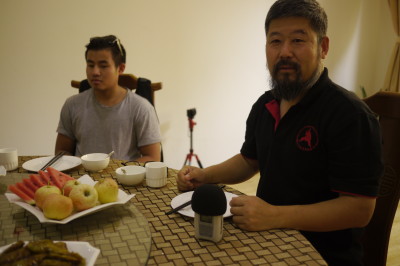 Here are some notes of a “Dinner-Lecture“, it was funny to re-listen 😉
Here are some notes of a “Dinner-Lecture“, it was funny to re-listen 😉
- if you can rotate your shoulder, the power from your body will transmit to your hand; many people fight tough but they have no power, because power comes from the ground, by connecting soledly on to the ground → this is upper body solution
- when the qua is open, your upper body will connect to the ground, if you can not connect to the ground your power is a superficial power
- saying: a piece of wood can stand 1000 pounds but if it`s cricket, it cannot stand anything
- you need to be straight, straight basically meens there is no deviation with the incoming force
- Read more
*This article was originally published in T’ai Chi, the International Magazine of T’ai Chi Ch’uan, Vol. 29, No.5, October 2005. ISSN 0730-1049, Wayfarer Publications, Los Angeles, CA 90039.
The following is my proposal for teaching Tai Chi at Paradise Valley Community College (Phoenix, AZ). It was accepted and the class will be scheduled for the Spring 2017.
Let’s do an experiment. Find a stick about a foot long. Put a mark on the center point. Use fingers of one hand to hold one end of the stick in horizontal position. Now, try to rotate the stick horizontally, and make the center point of the stick as the rotation center, and try your best to keep the center point not moving around. Soon you’ll find out that is not a simple task even though it sounds simple. This is not because you don’t have enough strength in your hand/arm to hold steady of the stick. It’s because you only control one end of the stick.
Master Chen’s disciple Ping Wei will teach a full day workshop in Irvine, California on August 21, 2016 (Sunday).
The workshop will cover foundations and Yilu; and it also prepares us for the upcoming Phoenix Workshop with Master Chen in October. For location and other details, please contact Al Yu, mralyu@yahoo.com, (949) 331-2735; or Ping Wei, peace_defender2003@yahoo.com, (602) 373-3457.
There are some small details in stepping forward and finishing the form that I have been focusing while doing Yilu. I’d like to share here and hopefully generate some discussion.
In Practical Method, we first (1) shuffle one heel out when we step forward. Then (2) we move the knee forward and the body is shifted to center (roughly).
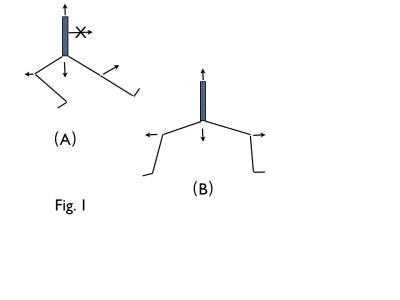 Some people would do (1) and (2) together, so it really looks like stepping and weight shifting are done at the same time. It’s partly due to the weak supporting leg. With more practicing and increased leg strength, it can be easily corrected.
Some people would do (1) and (2) together, so it really looks like stepping and weight shifting are done at the same time. It’s partly due to the weak supporting leg. With more practicing and increased leg strength, it can be easily corrected.
For registration please go to this link.
So I was wondering if anyone could let me know about the spine not moving, I am under the impression that if your feet do not move(not walking or stepping) then the spine from the bottom of the tail bone up to the top of the head stays in a straight line it. It may elevate through the bending and straightening of the legs, it may rotate through the turning of the waist, but it never ever moves. Is this the correct thought in all cases? Are there exceptions? of course it changes location when one steps but it does not bend? let me know what is what and thanks!!
I came across this video while surfing YouTube and was surprised to see that a lot of the concepts talked about are very similar to what I have heard Master Chen discuss, such as:
Don’t push at the contact point but don’t pull away either, use the elbow to pull/rotate around the contact point, use the center to move the body, apply power to the hand but not the arm, don’t engage or push into the opponent’s strength, …
Interested to hear other’s thoughts.





